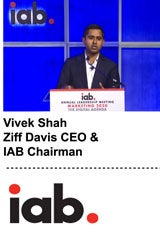 The Interactive Advertising Bureau (IAB) kicked off day one of the Annual Leadership Meeting (ALM) by rallying advertisers to raise the bar on marketing.
The Interactive Advertising Bureau (IAB) kicked off day one of the Annual Leadership Meeting (ALM) by rallying advertisers to raise the bar on marketing.
To do this, however, marketers and advertisers need to be more vigilant around traffic fraud. Additionally, they must also realize that consumer attention spans, especially in mobile, are short.
Holding Agencies Accountable
After IAB President and CEO Randall Rothenberg told the more than 1,000 attendees they are “defining the agenda for our industry,” newly appointed IAB Chairman and Ziff Davis Inc. CEO Vivek Shah admonished marketers for allowing traffic fraud to proliferate and urged them to end it.
Shah cited comScore’s finding that 36% of all traffic is nonhuman and noted that traffic fraud has reached “crisis proportions.”
“If we want to be the $60 billion industry we are today, we need to stop devaluing digital media,” Shah said. “No more traffic fraud. Let’s end it.”
Part of the blame, he said, falls on the agencies for continuing to use fraudulent traffic sources.
“Bogus impressions won’t infect the system if you don’t buy them, Mr. Agency Trading Desk,” Shah said. “You don’t go after drug dealers. You go after people taking the drugs.”
Building On Daily Habits
Nick D’Aloisio, product manager at Yahoo and the 18-year-old founder of the news-summarizing app Summly, replaced keynote speaker David Pogue, who canceled his speech “due to travel complications.”
D’Aloisio said he had been coding since he was 12 years old and, at age 15, raised VC funding from investors like Sir Li Ka-Shing, Rupert Murdoch and Marc Pincus. Yahoo acquired his app in March 2013 for $30 million.
In his address, D’Aloisio shared his observations about user behavior, mobile content and design. In terms of social media, the market is moving from an emphasis on social graphs and real identity to anonymity, he said.
Also, while users are accustomed to instant gratification, especially on mobile, the chances of creating a product that people will use spontaneously throughout the day are slim.
Instead, companies should focus on building reliance and regularity into their offerings. “There’s no point designing a mobile experience if you don’t think people will come back every day,” D’Aloisio said. “It has to be a daily habit.”











